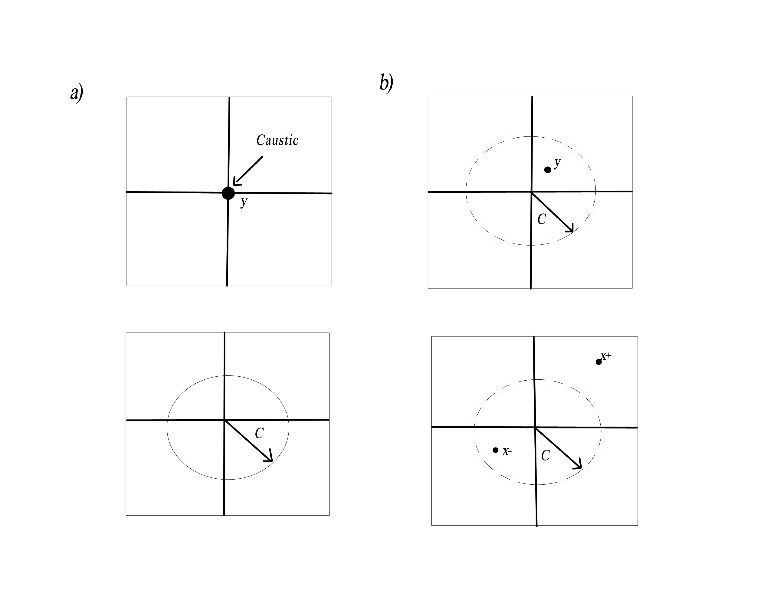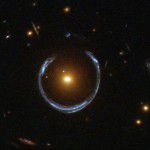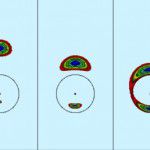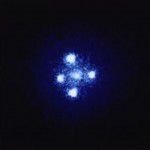We have looked at the ground-breaking, yet controversial, 1919 expedition by Sir Arthur Stanley Eddington which proved the theories of Albert Einstein to be true. Now, I want to look at some of the effects of Gravitational Lensing and also how this has become a vital tool in the astronomer’s utility belt (no shark repellent required).
Double Quasars and Einstein Rings
The position of the light emitting body (e.g. a star or galaxy) behind the large gravitational mass (our lens), in relation to the line of sight of the observer, is very important and causes different results.
The light emitting from the star does not have to arrive at the observer in one path. The light passes the large gravitational mass in one, two or four (see Einstein Cross below) directions. If the star is slightly off centre we get the apparent star position at a deflected angle and a secondary image (often hidden) in the opposite quadrant of view.
When visible, we can see two stars which, to the observer, seem to be two separate entities. When we study the properties of the stars and discover that they are in fact identical we can deduct a gravitational mass is present in the forefront of our observation.
If the star lies on/near the centre of the axis (i.e. the star, gravitational lens and observer along the straight line of sight) the light passes around the gravitational lens in all directions and we observe a beautiful effect of Gravitational Lensing called Einstein Rings.
Einstein Rings are distorted galaxies or stars which form rings of light or more typically arcs and horse-shoe shapes.
In the diagram above fig. (b) shows when y (the background star) is slightly off centre, the apparent position of the stars can now be observed at positions x+ (outside the Einstein Ring) and x- (inside the Ring and in the opposite quadrant)
In 1936 Einstein pointed out that, if a distant star were to be almost precisely behind a closer star, two ray paths would be possible through gravitational deflection of the rays by the closer star, and it would be seen as a double image. Einstein dismissed this as being most unlikely. Nevertheless, in an extragalactic context, his conjecture was realized in 1979 when Walshe, Carswell and Weymann discovered that the radio source B0957+561 was identified with a close pair of star-like images on a sky-survey plate: these turned out to be quasars, leading to the colloquial name “the double quasar” (Walshe et al. 1979). The two images, 6 arc seconds apart, were found to have identical spectra, both with redshift z = 1.41; the separation of the two images was due to gravitational `refraction’ in a `lensing’ galaxy on the line of sight, at redshift z = 0.36.
Fig. (a) above shows the result when y = 0. This results in an Einstein Ring. Einstein rings are a particularly interesting manifestation of Gravitational Lensing producing spectacular arcs and rings from distorted galaxies and stars. The first was discovered in the radio waveband by Hewitt et al (1987). About half a dozen radio rings are now known and these sources permit the most detailed modelling yet of the mass distributions of lensing galaxies. Paczynski (1987) proposed that the arcs are the images of background galaxies which are strongly distorted and elongated by the gravitational lens effect of the foreground cluster. This explanation was confirmed when the first arc redshift was measured and found to be significantly greater than that of the cluster.
Apart from the spectacular giant luminous arcs, which require special alignment between the cluster and the background source, clusters also often distort the images of other faint background galaxies (Tyson 1988). These distortions are mostly weak and corresponding images are referred to as arclets.
Below I have a slideshow of examples of Einstein rings and arcs caused by gravitational lensing: 

Dark Matter
Lensing can fall into several different categories; strong, weak and microlensing. For the most part, astronomers can only detect bright objects that emit lots of light or large objects that block background light, as discussed in these articles.
Microlensing allows the study of objects that emit little or no light and is used to describe Gravitational Lensing events where the lens is not massive enough to produce resolvable images of the background source. Microlensing, by individual stars in a lensing galaxy, is observed on rare but very important occasions. This form of lensing is currently being used in an interesting application at optical wavelengths.
A wide-angle camera with a CCD (charge-coupled device) detector array can be used to monitor a large number of stars, searching for the lensing effect of any massive body passing in front of any one of them. Monitoring programs of this kind are especially appropriate for the comparatively distant stars in the Galactic bulge and in the LMC (large magellanic cloud) in the hunt for single dark stars, or other compact objects known as MACHOs (massive astronomical compact halo objects).
The intention of this intensive search is to investigate whether some or all of the dark matter known to exist in the Galaxy can be attributed to compact stellar- or sub stellar-mass objects. By considering these galaxy masses, along with measurements of their sizes, brightness, and stellar velocities, the SLACS (Sloan Lens Advanced Camera for Surveys) astronomers were able to infer the presence of dark matter in addition to the visible stars within the galaxies. Dark matter is the mysterious, invisible material that is the majority of matter in the universe. And with such a large number of lens galaxies across a range of masses, the astronomers at SLACS found that the ratio of dark matter relative to stars increases systematically when going from galaxies of average mass to galaxies of much higher mass. Although work is ongoing, the work currently being done could explain one of the major astronomical anomalies. Below is a mosaic of the lensed galaxies observed by SLACS (click image to enlarge). Source: www.slacs.org.

The Shape of Stars
Most of the stars in the sky are point-like, making it very difficult to determine their shape. Recent progress in optical interferometry (a technique of superimposing electromagnetic waves to measure small displacements) has made it possible to measure the shape of a number of stars. An international team of astronomers, led by N.J. Rattenbury (from Jodrell Bank Observatory, UK), applied Gravitational Lensing techniques to determine the shape of one such star. Microlensing events occur over timescales from weeks to months, and require long-term surveys to be detected. Such survey programs have existed since the 1990s. Today, two survey teams are operating: a Japan/New Zealand collaboration known as MOA (Microlensing Observations in Astrophysics) and a Polish/Princeton collaboration known as OGLE (Optical Gravitational Lens Experiment).
The MOA team observes from New Zealand and the OGLE team from Chile.
The microlensing event that was used, the lensing of a binary star, was detected in July 2002 by the MOA group. The event is named MOA 2002-BLG-33 (MOA-33). Shapes of stars had been investigated and found before, such as the star Achernar (the flattest star ever found) although these stars are just a few parsecs from Earth. MOA-33 is a more distant star, about 5000 parsecs from Earth. Interferometric techniques can only be applied to bright (nearby) stars, whereas, the microlensing technique makes it possible to determine the shape of much more distant stars. In fact, there is currently no alternative technique to measure the shape of distant stars.
Finding Exoplanets
“The real strength of microlensing is its ability to detect low-mass planets,” states Dr. Ian Bond of the Institute for Astronomy in Edinburgh, Scotland, lead author of a paper appearing in the May 2004 Astrophysical Journal Letters. This marked the first discovery of a planet around a star beyond Earths solar system using gravitational microlensing. A star or planet can act as a cosmic lens to magnify and brighten a more distant star lined up behind it. The discovered star-planet system is 17,000 light years away, in the constellation Sagittarius. The planet, orbiting a red dwarf parent star, is most likely one-and-a-half times bigger than Jupiter (which itself it over 11 times bigger than Earth!). The planet and star are three times farther apart than Earth and the Sun. Together; they magnify a farther, background star some 24,000 light years away, near the Milky Way centre.
This discovery was made possible again through the cooperation between MOA and OGLE.
In most prior microlensing observations, astronomers saw a typical brightening pattern, or light curve, indicating a stars gravitational pull was affecting light from an object behind it. These observations revealed extra spikes of brightness, indicating the existence of two massive objects. By analysing the precise shape of the light curve, Bond and his team determined one smaller object is only 0.4 percent the mass of a second, larger object. They concluded the smaller object must be a planet orbiting its parent star. This technique is continually being used to search for exoplanets.
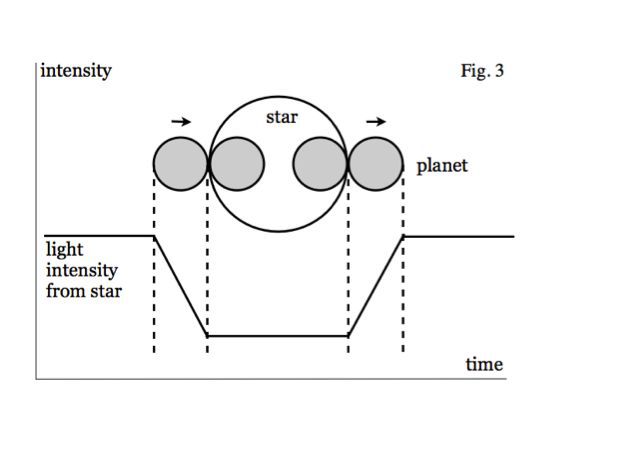
A simple diagram showing the fluctuations of brightness of a star-planet system. Source: exoplanets.com
Excitingly, this very year, astronomers are planning on using the passing of Proxima Centauri, the Sun’s closest neighbour which is 4.24 light-years away, in front of a distant star to take a peek into its solar system.
Using the methods described above, scientists can note any peaks of brightness to examine a possibility of planets in the solar system, something we haven’t yet been able to see. There may be no planets to speak of or they may just be too small to see with our conventional instruments.
October 2014 will be a significant time in the mapping of our local cosmic neighbourhood.
The Age and Size of the Universe
The most interesting use of Gravitational Lensing I have come across is applying it to measure the age and size of the universe. Researchers at the Kavli Institute for Particle Astrophysics and Cosmology (KIPAC) have used Gravitational Lensing to measure the distances light has travelled from a bright, active galaxy to the Earth along different paths. By interpreting the time it took to travel along each path of light and the speeds involved, researchers could conclude not just how far away the galaxy lies, but also the overall scale of the universe and infer some details of its expansion.
Distinguishing distances in space is difficult. A bright light far away, and a dimmer source lying much closer, can look like they are at the same distance. Gravitational Lensing combats this problem by providing multiple clues as to the distance light travels. This extra information allows them to determine the size of the universe, often expressed by astrophysicists in terms of a quantity called Hubble’s constant.
These measurements determine a value for the Hubble constant and confirms theage of Universe as 13.75 billion years old, within 170 million years.
When a large nearby object, such as a galaxy, blocks a distant object, such as a cluster of galaxies, the light can bypass the obstacle. But instead of taking a single path, light can bend around the object in one or two, or four different routes, thus doubling or quadrupling the amount of information scientists receive. As the brightness of the background galaxy nucleus fluctuates, physicists can measure the ebb and flow of light from the four distinct paths, such as in the B1608+656 system that was the subject of this study by KIPAC. Even though we cannot tell when the light has left its origin, we can compare the arrival times of the separate paths, in this case, four of them.
KIPAC’s Phil Marshall likened this characteristic to four cars taking different routes from one side of a city to another, stating: “The traffic density in a big city is like the mass density in a lens galaxy, if you take a longer route, it need not lead to a longer delay time. Sometimes the shorter distance is actually slower”.
The gravitational lens equations account for all the variables such as distance and density, and provide a better idea of when light left the background galaxy and how far it travelled. With this new information researchers have come up with a more accurate lensing-based value for Hubble’s constant and a better estimation of the uncertainty in that constant, thus achieving better estimations on the structure of the lens and the size of the universe.
Although there is still work to be done to lower the error margin by tackling problems such as dust within the lens, they are confident the use of lensing is the most accurate way of determining these sought-after answers.

